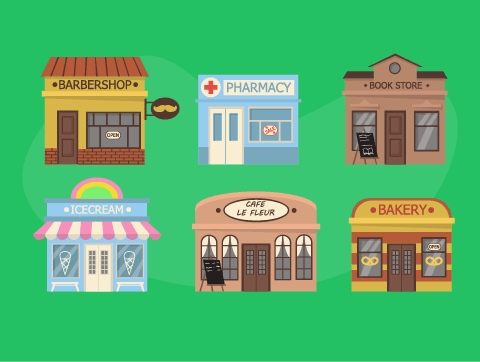Introduction
Small and medium-sized enterprises can operate in all kinds of different industries and provide a wide range of different services. We’ve also seen how they vary in size from as little as a single person to as many as 249 members of staff.
There are some characteristics though that we see quite often throughout all the various SMEs in different industries.
In this lesson, we’ll learn about the features of SMEs, including:
- Being run by a single individual or small team of people
- Having a physical location and/or online operation
- Being the sole employment or as part of a hobby/side hustle
- Existing in one or more sectors of the economy

Running an SME
Small and medium-sized enterprises are often operated as sole traders or as partnerships.
However, even those that are running as a limited company or LLP are typically still run by a single individual or small team of people.
This small group of people are often the owners of the enterprise, who typically are involved in all aspects of the day-to-day running of the business and may even be the only employees of the business too (particularly in micro-sized businesses).
Running the enterprise themselves allows the owner to have full control over decision-making in how to take the business forward without having to give up control to others.
Giving up control can often be difficult for owners of SMEs as they will feel that anyone taking over running will not have as much personally invested in the business’s success.

Location of the SME
An SME can often start out running from the home of the business owner. This is possible because often the business will be entirely run by the owner/s and won’t have any other employees.
Operating this way saves the owner on the cost of premises and has the benefits of working from home.
SMEs that operate from home can often use a “Virtual Office” where the business pays a monthly fee for a professional office address, a business phone number and potentially access to office space for meetings on occasional circumstances.
As the business grows, they may operate from an office, though this might be a case of owning a desk or small section of an office rather than paying for a larger space that they would not need.

Location of the SME
Many SMEs operate entirely online. This can include having a website that handles all sales, but also could involve holding all meetings virtually via online meeting software (e.g. Zoom).
This can be beneficial for those working from a home office but who still need to hold meetings with clients and customers.

Employment Status
The owner of an SME may work on the business full-time as their sole employment.
When operating as a sole trader or partnership they would be legally classified as “self-employed” and be required to perform self-assessed tax returns.
However, for many SME owners, the step of leaving their regular employment is too much of a risk, especially during the early days when the enterprise may not be generating enough profits to cover their salary.
In these cases, the enterprise is run more as a hobby or “side hustle” that supplements the income they make from their regular salaried job.
This allows the owner to test out the waters and then move part-time in their job before moving entirely into being self-employed.

Sectors of the Economy
A sector is a particular area of the economy in which an enterprise operates. These sectors are typically defined by the activities performed and products or services offered.
We can commonly split these sectors into four different categories:
Primary – businesses that extract natural raw materials from the earth, such as farming, fishing & mining.
Secondary – businesses that produce goods from the natural raw materials, such as car manufacturing, utility services and building construction.
Tertiary – businesses that provide access to services to businesses and customers, such as retailers, restaurants and estate agents.
Quaternary – businesses that are involved in academic and intellectual activities, such as education and research & development.

Sectors of the Economy
An SME will often operate in a single sector, such as education.
Due to the size of the business, it can be difficult to access the variety of skills required to operate in multiple sectors.
Even internal departments, such as finance, may be outsourced to external businesses rather than being handled by the business itself.

Lesson Summary
Small and medium-sized enterprises are often operated as sole traders or as partnerships.
Typically they’re run by a single individual or small team of people (usually the owners).
This allows them to retain control over all business decision making.
An SME can often start out running from the home of the business owner.
Virtual offices are sometimes used by those running a business from home.
Operating online can be done through business websites and video conferencing.
SME owners often run the business as a hobby or “side hustle” alongside a regular job.
